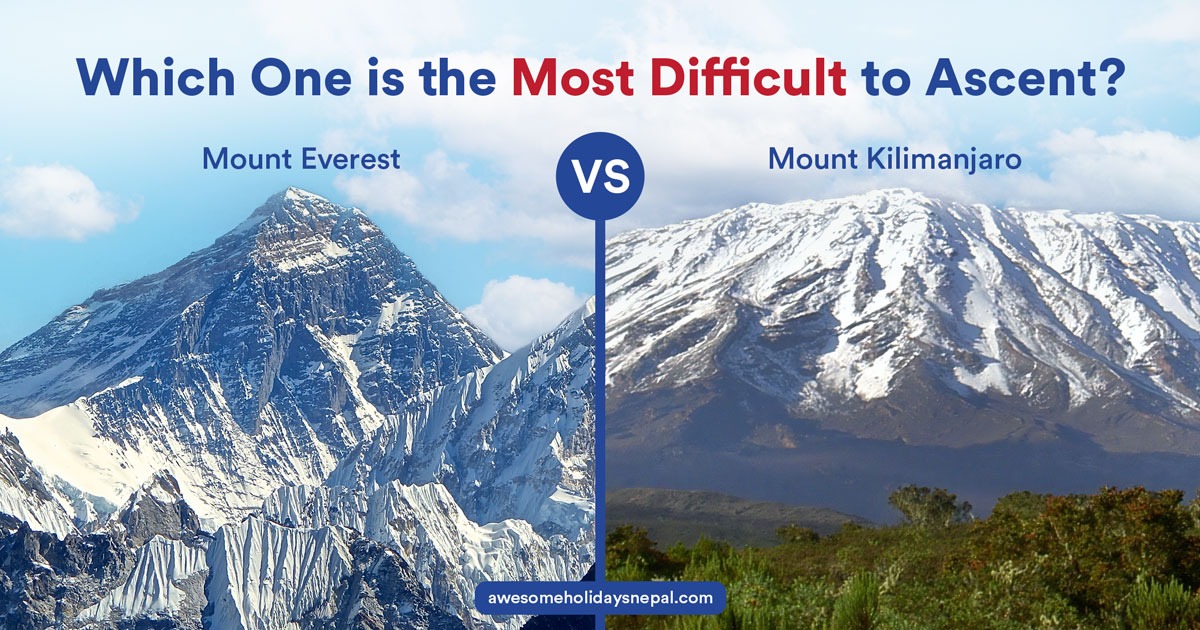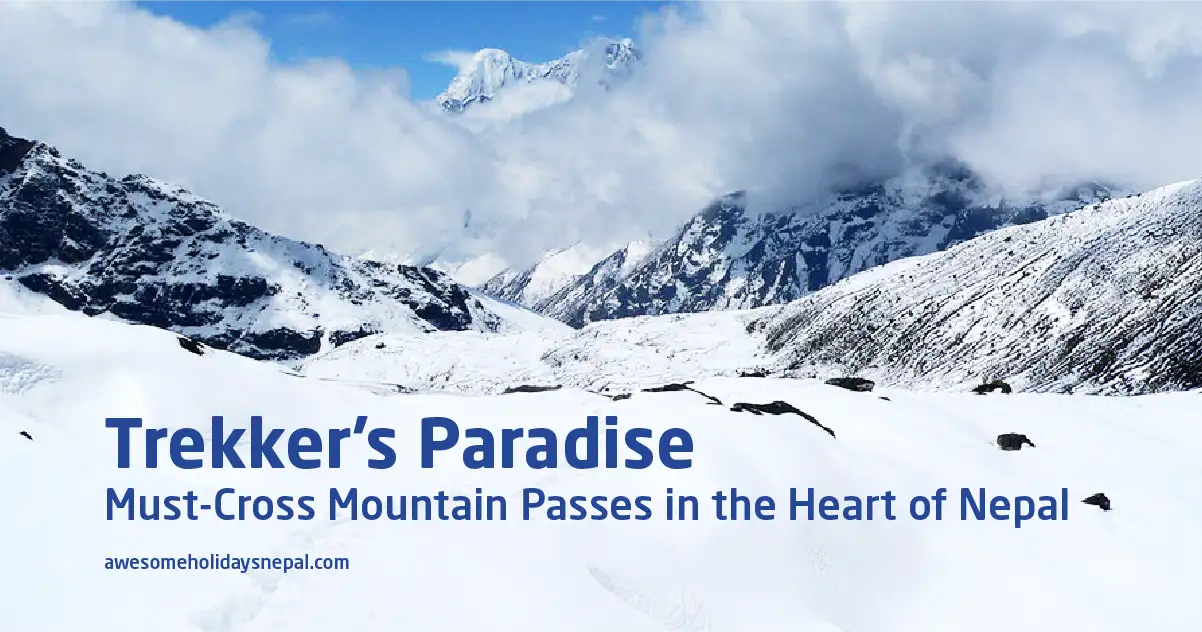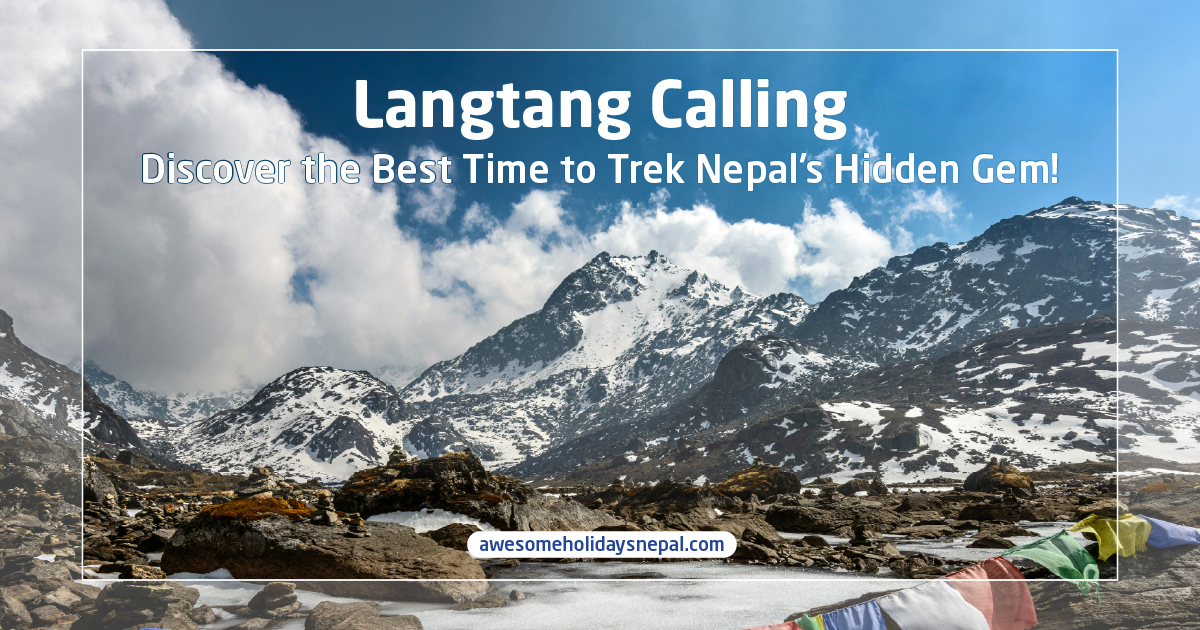Everest Vs. Kilimanjaro: Which One is the Most Difficult to Ascent?

Everest vs. Kilimanjaro: Which is the most difficult to ascent? This has been a long-running debate among the trekking fraternity. While Mount Everest, located in Nepal, is known as the highest peak in the world, Kilimanjaro has gained popularity as the highest free-standing mountain above sea level.
Often known as a dormant volcanic mountain, Kilimanjaro is the highest mountain in Africa and one of the seven summits in the world. Similarly, Everest, also known as Sagarmatha, is the highest of the seven summits and is enlisted as a world heritage site.
Indeed, both mountains have their essence and popularity among climbers, but the controversy over which one is the tallest is never-ending. Let’s dig deeper into each, from a trekker’s perspective, to decide which is most challenging to climb, Everest or Kilimanjaro.
How to Decide Which is Harder to Climb: Everest vs. Kilimanjaro

Being the tallest peak, Everest, compared to Kilimanjaro, must be the most difficult to climb. However, altitude isn’t the only thing that determines how hard your trek to the mountain is going to be.
Other parameters, such as frequency of change in altitude, steepness, length, ruggedness of trail, climatic conditions, etc., also play a part in making the experience a challenge to the summiteers. We will analyze all these aspects before making a concrete decision on which is more challenging.
Height of the Peak
There’s no doubt that Everest stands out with an altitude of 8848.88 meters (from sea level). In fact, the elevation of even Everest Base Camp is higher than that of Mount Kilimanjaro’s top.
However, there is an ongoing debate on the altitude, considering that Kilimanjaro is a volcanic mountain with a major part submerged inside the crust. When measured from the center of the earth, Kilimanjaro happens to be 6384 kilometers high, whereas it’s 6382.3 kilometers for Everest.
Even though researchers have had a clash of opinions, it is a fact that Everest’s altitude does make it difficult to ascend. If not directly, its altitude impacts other factors such as the availability of oxygen, change in climate, and length of the route.
In contrast, Kilimanjaro might be more accessible in terms of the additional factors, but the rapid change in altitude while climbing the peak does make it more difficult. Being a shorter peak, people rush to complete the ascent and end up getting tired early and catching altitude sickness, making it harder to climb than Everest.
Steepness of the Peak
How steep is the trail? It is a significant factor that determines the ease of the ascent, no matter which mountain you are climbing. Applying the basic law of physics, the steeper the surface, the more effort one requires to climb through it.
The steepness of the trails is almost equal in both treks. However, one needs to cover most of that steepness in a day on the final summit, as in the case of Kilimanjaro, compared to Everest, which has a gradual increase. Since climbing Everest takes longer, the climbers get enough days to adapt to the increasing slope.
Thus, you will find Kilimanjaro more difficult to climb in this regard.
Longer Routes
Given the mountain’s altitude, it is indisputable that the trekking routes to Everest are comparatively more prolonged than those to Kilimanjaro. It takes a minimum of 11 days to trek to the Everest base camp; however, you can climb Kilimanjaro easily in most of the 5 days.
Depending on the itineraries you choose, the trail routes and number of days taken to complete the trek might vary. However, the trek to Everest is comparatively more tiring than to Kilimanjaro, no matter which route you take.
To be precise, having a longer trekking route has both pros and cons, and it also contributes to making the trek challenging. Considering that one needs to acclimatize to the atmosphere and adapt to the altitude to prevent sickness, a longer route does make it easy to climb Everest.
Contrastingly, it might be a difficult thing if your physical fitness gives up or if your morale goes down thinking of the distance yet to cover.
Climatic Conditions
Apart from the geographical conditions, the climatic conditions of the mountainous region determine the difficulty of the trek. Again, because of the higher altitude, the Everest region has more extreme climatic conditions, which often drop below freezing at night.
In addition, the climatic conditions in the Everest region change frequently over a short period of time. Even in the climbing seasons of Spring and Fall, you might see a faint sun in one moment and a drizzling sky in the other. Such an unpredictable climate diminishes visibility and makes the atmosphere colder, making it difficult to continue the trek.
In fact, the unpredictable climate often delays flights to Lukla, results in worsening health conditions, and often causes the death of climbers.
Similar extreme climatic conditions exist on Mount Kilimanjaro. Many of the deaths on this journey result from altitude sickness, high-altitude pulmonary and cerebral edema, and heart attacks. Thinking of the shorter route, people often hurry up to summit the peak, which often results in catastrophic health conditions.
Possibility of Natural Disaster
The Everest region has more incidents and the possibility of natural disasters. This has even led to the saddening demise of many climbers who happened to be at the right place at the very wrong time. Given the frequent avalanches, swiftly changing climatic conditions, and the most dangerous Khumbu Icefall en route to the summit of Everest, it is definitely the hardest journey.
While discussing the higher risk of disaster in Everest, we cannot claim that Kilimanjaro is free from this risk. Sudden rockfall from this volcanic mountain has often killed many climbers. Besides, it is a dormant volcano that always holds the risk of being active again and causing unprecedented volcanic eruptions.
Conclusively, none of the mountains are safe from natural disasters; however, the frequency of occurrence is higher in the case of Everest. Hence, in terms of the possibility of disasters while on the ascent, Mount Everest is more difficult to climb.
The Summit Night
Lastly, the summit night at Mount Kilimanjaro is one of the primary reasons why most climbers consider it more difficult—even more difficult than Everest. To make it clear to you, summit night is the time from noon on the summit day till midnight on the very same day. You are supposed to ascend the summit and descend back to the campsite within a period of 12 hours or so.
Given the duration it takes and how punctual you need to be for this timed ascent and descent, Kilimanjaro is indeed a difficult one to climb.
Whilst every night spent at all four base camps en route to the summit of Everest is risky, there’s no specific case of summit night difficulty. However, the Everest region is also not free of a similar summit rule.
On the final ascent, you need to wake up as early as you can and climb the peak in the darkness so that you can start descending back towards the base camp before 2 p.m. Since the weather starts to get unpredictable after 2, this rule is necessary to ensure your safety while descending. Many notable climbers, like Pasang Lhamu Sherpa, lost their lives in the snow-covered mountains just because they weren’t able to descend on time.
Everest vs. Kilimanjaro: The Decision
If one has to be honest, there is no such distinct answer on which mountain is more difficult to climb, either Everest or Kilimanjaro. It is totally up to you what measures you can take to prevent possible risks and mitigate them in case you get stuck on the ascent.
While Everest has risks associated with unstable weather, poor climate conditions, and avalanches, the summit night of Kilimanjaro makes it equally harder for the trekkers. Besides, the average success rate of the summits in both peaks is around 60%.
But if I had to decide which one to climb first, I would suggest opting for Everest. Not only will you experience the glory of ascending to the world’s highest peak, but you will also have a chance to explore the country’s unique natural and cultural heritage. You can also opt for a luxurious Helicopter sightseeing tour or trek to Everest Base Camp before you try for the summit.
Related blog posts
Discover a choice of tourist destinations loved by most of our visitors. Whether you're on a jungle safari to spot rare animals or walking through a world heritage site, these well-planned itineraries cover the major highlights of Nepal.



